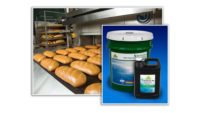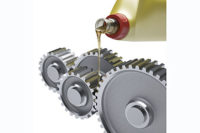Meat and poultry producers are getting greater operational relief from their use of grease.
Enhancements to food-grade lubricants, including greater water resistance and the ability to work more effectively under higher temperatures and when supporting heavier loads, are enhancing plant operations.
Yet for optimal functionality, operators still must leverage the most pertinent products for their specific technologies and follow appropriate maintenance schedules.
“There are fewer challenges than in the past when using food-grade lubricants because the greases are no longer of poor quality,” says Chuck Coe, president of Grease Technology Solutions LLC, a Manassas, Va.-based grease training and consulting company. “There are excellent selections that are performing as well or better than non-food-grade greases.”
While he notes that food-grade lubricants “still come at a premium price,” Coe says users “are getting good performance value for the money.”
Food-grade lubricants typically are more costly because of the use of white oils or synthetic base oils which drive up the raw materials costs, he notes.
“Lubricant formulators have risen to the challenges of the food industry and the specific environmental conditions — heat, steam, cold, condensation, biological matter — that make food processing equipment challenging to lubricate, operate and protect,” says Ashlee Breitner, business unit manager, non-compound foods, for NSF International, an Ann Arbor, Mich.-based certifier of lubrication products and systems. “More companies are starting to use more innovative ingredients to meet the ever-changing performance needs of food-grade lubricants.”
It is a change from the past when, for safety reasons, some of the most effective chemical additives were not permitted in food-grade applications, says Jim Fitch, chief executive officer of Noria Corp., a Tulsa, Okla.-based lubrication consulting and training firm.
“It was affecting how well the lubricants were protecting bearings, gears, sliding surfaces and other areas where there is friction and wear,” he says.
To further enhance greases, suppliers are improving oxidation stability in order to extend the service life of lubricants as well as to enhance film strength, Fitch says.
A sea of lubricant possibilities
But while manufacturers are enhancing the performance of lubricants, meat and poultry producers still face the issue of leveraging the most appropriate selections if they are to best protect equipment.
“The number of food-grade lubricant suppliers has risen steadily over the last few years which is a positive development for plant operators,” Breitner states. “But it can also present a challenge in terms of finding the right supplier to work with.”
Indeed, Fitch notes “thousands of lubricants are available with different performance and price points. The choices are much different today than 10 years ago.”
Procuring the ideal lubricants to apply to a gear drive, conveyor or compressor system may require operators to use selections from different suppliers, he adds. Such products can differ in the degree of viscosity and assortment of additives.
“There is a need and desire for reliability at the lowest possible cost,” Fitch says. “Plants can’t just throw darts at a board to find the best lubricants.”
Assistance can come from manufacturers who understand food safety principles and applications and will provide ongoing product application and technical support, Breitner states.
One of the biggest mistakes made by plant operators, meanwhile, is not following the proper usage instructions, she adds.
For best results, it also is crucial for producers to devise a lubricating program and not just follow a preventive maintenance schedule, Coe says, adding that such a plan should cover grease management.
That includes clearly labeling the grease containers to reduce the risk of using the wrong lubricants on machines or accidently blending food-grade and conventional lubricants.
“It is a big opportunity for screw-ups,” Coe says. “Plants are known to have a history of problems by mixing lubricants.”
Applying different types of greases to a piece of equipment can result in excessive softening of the lubricants, which can lead to product leakage and failure.
It also is important that lubricant containers are not left open after use in order to avoid contamination by other greases, dirt or moisture, Coe says.
“There can be product recalls if the wrong lubricant gets in touch with foods,” he says.
Operational considerations
Meat and poultry producers also should work with their lubrication suppliers in developing storage procedures, as well as determining how often they should apply grease and the optimal amounts to use, Coe says.
Factors include the number of hours that equipment is running, the speed of the technology, the ambient temperature of machines, frequency of equipment wash downs and processing volumes.
Older equipment also may have worn seals that enable grease leakage and require more frequent lubricant applications.
It is vital, however, that there is not excessive use of greases as too much can cause the temperature of bearings to rise, resulting in a degrading of the lubricants, Coe notes.
To help avoid such occurrences, it is important that plants devise and closely follow schedules for treating specific types of equipment.
“Plant maintenance personnel should not just lubricate equipment with a grease gun when they feel like it and/or apply random amounts of grease to the machines,” Coe says. “Lubrication is most effective when there is a controlled program in the facility.”
To help minimize the chance of human error in administering a lubrication program, operators also can automate the process, he adds. Automating reduces the prospect of cross contamination from plant personnel applying the wrong greases to machines or exposing the equipment to dirt or other elements.
While food-grade lubricants are becoming more potent, meanwhile, it also is important that suppliers keep upgrading formulations in order to keep pace with enhancements to the machines, Breitner adds.
“This will cause lubricant manufacturers to tinker with new and innovative ingredients in their research and development processes to meet the needs of this industry from a safety and performance standpoint,” she says. NP





Report Abusive Comment